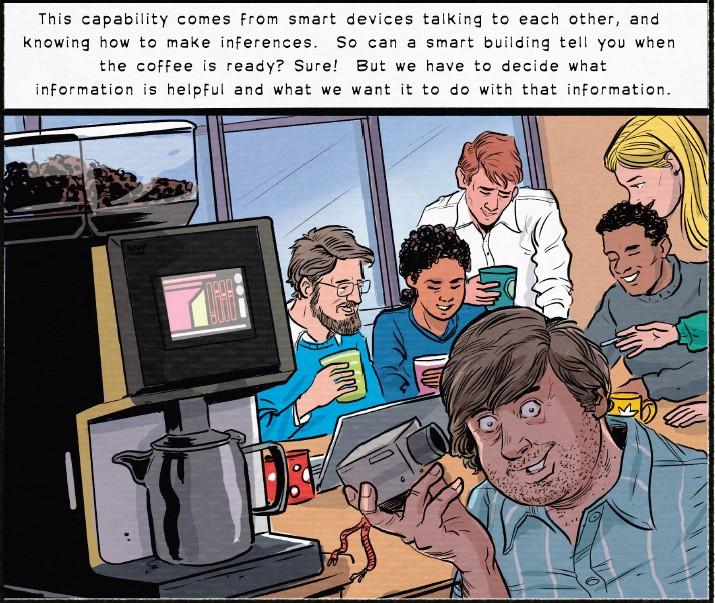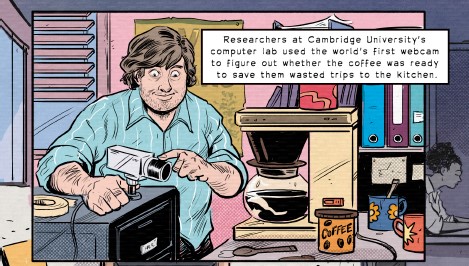
Submitted by Anonymous on Mon, 24/01/2022 - 15:24
Sensor technology has come a long way over the last 30 years, from the world’s first, bulky webcam at the University of Cambridge Computer Science Department to near ubiquitous networks of sleek sensors that can provide data at an unprecedented volume, velocity and quality. Today, sensors can even talk to each other to combine single points of data into useful insights about complex events. The new webcomic ‘Coffee Time’ by Dave Sheppard, part of the Digital Twin Journeys series, tells the story of this evolution and what it means for what we can learn about our built environment through smart sensors.
Starting with a simple problem – is there coffee in the lab’s kitchen? – researchers in the early 1990s set up the world’s first webcam to get the information they wanted. Today, people in the Computer Lab still want to know when the coffee is ready, but there are more ways to solve the problem, and new problems that can be solved, using smart sensors. Smart sensors don’t just send information from point A to point B, providing one type of data about one factor. That data needed to be collated and analysed to get insights. Now sensors can share data with each other and generate insights more instantaneously.
The West Cambridge Digital Twin team at the computer lab have looked at how specific sequences of sensor events can be combined into an insight that translates actions in the physical world into carefully defined digital events. When someone makes coffee, for example, they might turn on a machine to grind the coffee beans, triggering a smart sensor in the grinder. Then they’d lift the pot to fill it with water, triggering a weight sensor pad beneath to record a change in weight. Then they would switch the coffee machine on, triggering a sensor between the plug and the outlet that senses that the machine is drawing power. Those events in close succession, in that order, would tell the smart sensor network when the coffee is ready.
These sequences of sensor triggers are known as complex events. Using this technique, smart sensors in the built environment can detect and react to events like changes in building occupancy, fires and security threats. One advantage of this approach is that expensive, specialist sensors may not be needed to detect rarer occurrences if existing sensors can be programmed to detect them. Another is that simple, off-the-shelf sensors can detect events they were never designed to. As the comic points out, however, it is important to programme the correct sequence, timing and location of sensor triggers, or you may draw the wrong conclusion from the data that’s available.
Something as simple as wanting to know if the coffee is ready led to the first implementation of the webcam. Digital twin journeys can have simple beginnings, with solving a simple problem with a solution that’s accessible to you, sparking off an evolution that can scale up to solve a wide range of problems in the future.
You can read and download the full webcomic here.
You can read more from the West Cambridge Digital Twin project by visiting their research profile.
This research forms part of the Centre for Digital Built Britain’s (CDBB) work at the University of Cambridge. It was enabled by the Construction Innovation Hub, of which CDBB is a core partner, and funded by UK Research and Innovation (UKRI) through the Industrial Strategy Challenge Fund (ISCF).
To join the conversation with others who are on their own digital twin journeys, join the Digital Twin Hub.

